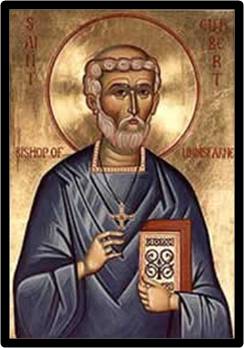MARCH 20 - ST. CUTHBERT

St. Cuthbert was born somewhere in the British Isles. He was a poor shepherd boy who lost his parents when he was very young. Cuthbert loved to play games with his friends and he was very good at them.
One of his friends scolded him one day saying, “Cuthbert, how can you waste your time playing games when you have been chosen to be a priest and a bishop?” These words sounded strange coming from his playmate - as though they were not his own. Cuthbert was confused and very impressed and he wondered if he really was going to be a priest and a bishop.
In August, 651, fifteen-year-old Cuthbert received a vision. He first saw a totally black sky. Then suddenly a bright beam of light moved across it. In the light were angels carrying a ball of fire up beyond the sky. Sometime later, Cuthbert found out that on the night of the vision, the bishop, St. Aiden, had died.
Cuthbert did not know what this vision meant but he made up his mind to become a Benedictine monk and entered the monastery of Melrose, which had been founded by St. Aiden. Cuthbert became a priest and a bishop as foretold by his young playmate many years earlier.
From one village to another, from house to house, St. Cuthbert went, on horse or on foot. He visited the people to help them spiritually. He also worked and helped plague victims. Best of all, he could speak the language of the peasants because he had once been a poor shepherd boy.
He did good everywhere and brought many people to God. Cuthbert was cheerful and kind. People felt attracted to him and no one was afraid of him. He was also a prayerful, holy monk who had the gifts of healing and prophecy (telling the future).
When Cuthbert was ordained a bishop, he worked just as hard as ever to help his people. He visited them no matter how difficult the travel on poor roads or in very bad weather. As he lay dying, Cuthbert begged his monks to live in peace and charity with everyone.
He died peacefully at Lindesfarne in Ireland in 687. His body which has not decayed can be seen in the Durham Cathedral even today.
